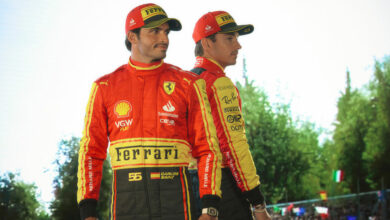F1 2023 Season Update: Aero Loopholes Impact Racing Dynamics, FIA Addresses Challenges
In the recent development of the 2023 Formula 1 season, FIA’s single-seater director Nikolas Tombazis shed light on the adverse impact of aerodynamic loopholes on close racing. This revelation highlights a significant challenge in maintaining the quality of on-track competition.
Key Takeaways:
- Aero Loophole Exploitation: Teams in the Formula 1 circuit have exploited loopholes in the technical regulations, leading to increased outwash and turbulent air, thereby hampering the ability of cars to follow each other closely on the track.
- Increased Tire Wear and Temperature Issues: The exploitation of these aerodynamic loopholes has contributed to increased tire degradation, notably impacting teams like Ferrari in the early stages of their campaign. The wake from the leading car is affecting the trailing car’s downforce and cooling, leading to reduced grip and overheating tires.
- No Immediate Intervention Planned: Despite these challenges, the FIA and Formula 1 authorities do not plan any regulatory intervention until the 2026 cycle. However, Tombazis remains optimistic that the wake effect will not worsen in the immediate future.

The 2023 Formula 1 season has been marked by a significant revelation from Nikolas Tombazis, the director of the FIA’s single-seater department. Tombazis acknowledged that the exploitation of loopholes in the technical rules by Formula 1 teams has negatively impacted the spectacle of close racing. The technical regulations overhaul in 2021 aimed to make cars easier to follow by minimizing the effects of turbulent air and enhancing overtaking opportunities. However, advancements in aerodynamics have led to an increase in a car’s outwash, which in turn, has made it more challenging for drivers to follow closely and overtake.
Speaking to the media, Tombazis expressed his concerns: “Close following, let’s say the wake, has definitely got a bit worse this year. We knew it would deteriorate a bit when people developed a bit more. There were a few particular areas of the car where some loopholes we didn’t manage to close soon enough.”
One of the significant consequences of this aerodynamic issue has been on tire performance. Teams have struggled with tire degradation, a problem most notably impacting Ferrari early in the season. The wake generated by the cars consists of slow-moving air, which not only reduces the downforce for the trailing car but also impedes its cooling process. This results in reduced grip and a higher risk of overheating the tires.
Despite these challenges, the FIA and Formula 1 authorities have no immediate plans to intervene or alter the regulations until the next regulation cycle in 2026. Tombazis remains hopeful that the current situation will not exacerbate and that the ability of cars to follow each other closely will not significantly diminish. He concluded, “I don’t think it’s going to get much worse for next year because I don’t think there’s any other loopholes to scrape through – the front wing area, and so on. I expect it’s going to stay very similar.”
This situation presents a unique challenge for teams and drivers as they navigate the remainder of the 2023 season, balancing the need for competitive edge with the overarching goal of maintaining the integrity and excitement of Formula 1 racing.


